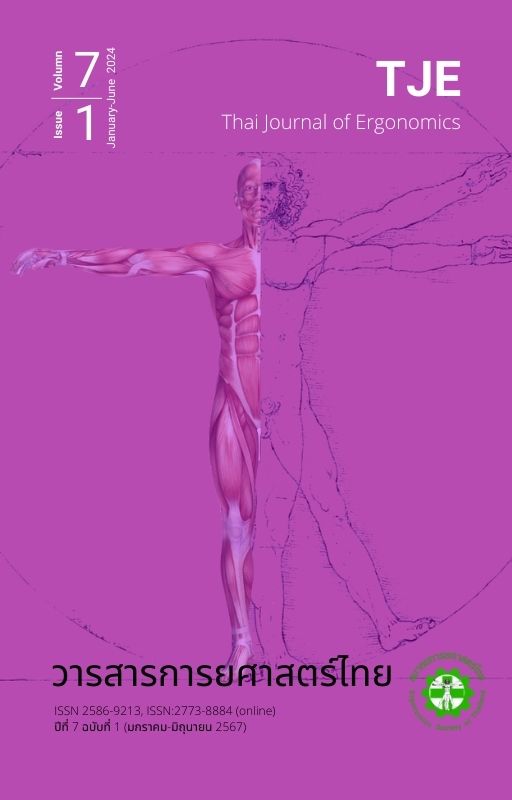Application of motion economy for reducing musculoskeletal disorders risk factors among cable packers in an enterprise
Main Article Content
Abstract
This study examined the risk factors for developing musculoskeletal disorders (MSDs). The principles of motion economy were applied to improve work methods for reduce the MSDs risk in ten volunteer cable packers. This study used a one-group quasi-experimental design. Working procedures were investigated using the flow process chart. Posture analysis evaluations using the Rapid Entire Body Assessment (REBA) tools have been used to analyses the working postures of cable packers in an enterprise. The risk factors were found to include twisting/bending/flexing the wrists, lifting/moving, flexing/twisting/lateral bending of the trunk, bending/twisting/tilting of the neck, knee flexion, unilateral weight bearing on the legs, and continuous standing. The intervention included the use of the human body, the arrangement of the workplace, and the design of tools and equipment. Post-intervention results showed the reduction of risk factors of twisting/flexing, bending/flexing, hand, and forearm reaching, and significant unilateral weight bearing on the legs (p < 0.005). The risk level as for REBA, the score was reduced for 13 to 7 indicated a decrease from very high to moderate risk levels. Findings implied that principles of motion economy could be applied to improve work methods by reducing the risk factors that may affect the workers’ musculoskeletal disorders.
Article Details

This work is licensed under a Creative Commons Attribution-NonCommercial-NoDerivatives 4.0 International License.
References
Tumme S, Meepradit P, Yingratanasuk T. The ergonomic risk assessment of working method and working posture among cable wire packing factory workers. The 52 National Graduate Research Conference, Burapha University. 2021:1122-35.
Kanawaty G. Introduction to work study the fourth (revised) edition. International Labour Office. Germany. 1992.
Hignett S, McAtammney. Rapid Entire Assessment (REBA). Appl Ergon. 2000; 31(2):201-5.
Hakim LA, Sevdalis N, Maiping T, Watanachote C, Sengupta S, Dissaranan C. Human error identification for laparoscopic surgery: development of a motion economy perspective. Appl Ergon. 2015;50:113-25.
Department of Health and Human Services. Practical demonstrations of ergonomic principles. [Internet]. 2011. [cited 2021 August 8]. Available from:
https://www.cdc.gov/niosh/mining/UserFiles/works/pdfs/2011-191.pdf
Joint project of the International Ergonomics Association (IEA). International Commission on Occupational Health (ICOH). Ergonomics guidelines for occupational health practice in industrially developing countries. 2010.
Health and Safety Executive. Reducing awkward postures. [Internet]. 2021 [cited 2023 August 4]. Available from: https://www.hse.gov.uk/msd/uld/art/awkpostures.htm
Sawertchaikul S, Lertsudvichai J. Analytical of ergonomics problems and work improvement for a moving and installation a stainless pipe worker in construction site. The 5th National Conference, Nakhonratchasima College. 2018:347-58.
Mahmooda S, Hardana MN, Samatb MK, Jiranc NS, Shaari MF. Ergonomic posture assessment of butchers: a small enterprise study in Malasia food industry. Jurnal Teknologi (Sciences & Engineering). 2019;81(6):89–102.
Meepradit P, Saowaros S, Yingratanasuk T. Working methods improvement for reducing hand risks among chicken scraping workers. Chonburi Hospital Journal 1975;43(2):95-100.
Surawut P. An improvement of vermicelli packing using ergonomics. [Thesis]. Bangkok :Thammasat University; 2015.
Zar M, Black N, Sagot J.-C, Hunault G, Roquelaure Y. Ergonomics interventions to reduce musculoskeletal risk factors in a truck manufacturing plant. Int J Ind Ergon. 2020;75:102896.
Duangsri J, Meepradit P, Yingratanasuk T. The result of workstation height improvements to reduce lower back risk among old wood craft workers in Paisan sub-district, Prakhonchai district, Buriram province. The 6th STOU National Research Conference. Sukhothai Thammathirat Open University. 2016.
Ramsey T, Davis KG, Waters T. Reduction of Spinal loads through adjustable interventions at the origin and destination of palletizing tasks. Hum Factors 2014; 56(7):1222–34.


